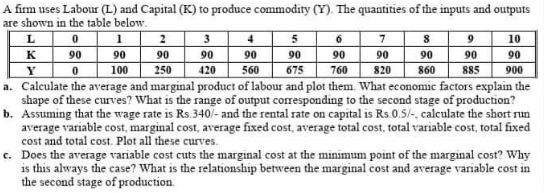A firm uses Labour (L) and Capital (K) to produce commodity (Y). The quantities of the inputs and outputs are shown in the table below. L 3 2 90 250 4 5 6. 10 K 90 90 885 90 90 90 90 90 90 90 90 Y 100 420 560 675 760 820 860 900 a. Calculate the average and marginal product of labour and plot them. What economic factors explain the shape of these curves? What is the range of output corresponding to the second stage of production? b. Assuming that the wage rate is Rs.3407- and the rental rate on capital is Rs.0.5/-, calculate the short run average variable cost, marginal cost, average fixed cost, average total cost, total variable cost, total fixed cost and total cost. Plot all these curves. c. Does the average variable cost cuts the marginal cost at the minimum point of the marginal cost? Why is this always the case? What is the relationship between the marginal cost and average variable cost in the second stage of production.
A firm uses Labour (L) and Capital (K) to produce commodity (Y). The quantities of the inputs and outputs are shown in the table below. L 3 2 90 250 4 5 6. 10 K 90 90 885 90 90 90 90 90 90 90 90 Y 100 420 560 675 760 820 860 900 a. Calculate the average and marginal product of labour and plot them. What economic factors explain the shape of these curves? What is the range of output corresponding to the second stage of production? b. Assuming that the wage rate is Rs.3407- and the rental rate on capital is Rs.0.5/-, calculate the short run average variable cost, marginal cost, average fixed cost, average total cost, total variable cost, total fixed cost and total cost. Plot all these curves. c. Does the average variable cost cuts the marginal cost at the minimum point of the marginal cost? Why is this always the case? What is the relationship between the marginal cost and average variable cost in the second stage of production.
Chapter7: Production And Cost In The Firm
Section: Chapter Questions
Problem 3.7P
Related questions
Question

Transcribed Image Text:A firm uses Labour (L) and Capital (K) to produce commodity (Y). The quantities of the inputs and outputs
are shown in the table below.
L
3
2
90
250
4
5
6.
10
K
90
90
885
90
90
90
90
90
90
90
90
Y
100
420
560
675
760
820
860
900
a. Calculate the average and marginal product of labour and plot them. What economic factors explain the
shape of these curves? What is the range of output corresponding to the second stage of production?
b. Assuming that the wage rate is Rs.3407- and the rental rate on capital is Rs.0.5/-, calculate the short run
average variable cost, marginal cost, average fixed cost, average total cost, total variable cost, total fixed
cost and total cost. Plot all these curves.
c. Does the average variable cost cuts the marginal cost at the minimum point of the marginal cost? Why
is this always the case? What is the relationship between the marginal cost and average variable cost in
the second stage of production.
Expert Solution
This question has been solved!
Explore an expertly crafted, step-by-step solution for a thorough understanding of key concepts.
This is a popular solution!
Trending now
This is a popular solution!
Step by step
Solved in 4 steps with 2 images

Knowledge Booster
Learn more about
Need a deep-dive on the concept behind this application? Look no further. Learn more about this topic, economics and related others by exploring similar questions and additional content below.Recommended textbooks for you



Exploring Economics
Economics
ISBN:
9781544336329
Author:
Robert L. Sexton
Publisher:
SAGE Publications, Inc



Exploring Economics
Economics
ISBN:
9781544336329
Author:
Robert L. Sexton
Publisher:
SAGE Publications, Inc


Economics (MindTap Course List)
Economics
ISBN:
9781337617383
Author:
Roger A. Arnold
Publisher:
Cengage Learning
